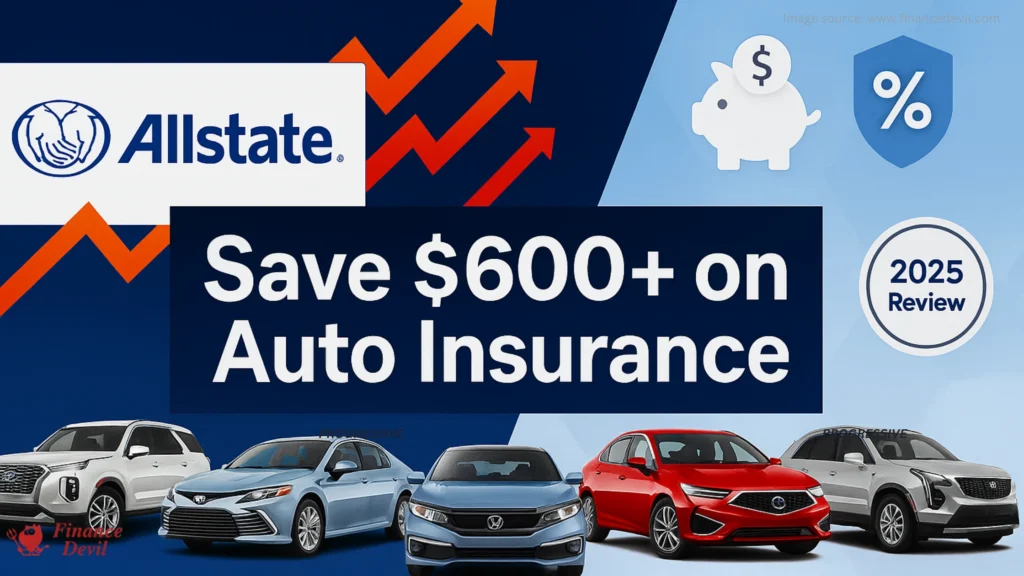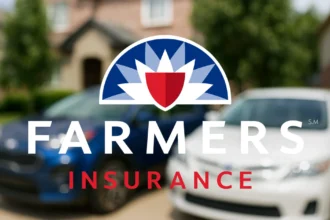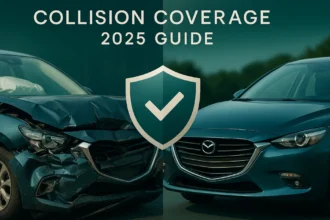
Why Millions of Americans Are Overpaying for Car Insurance
Here’s what most drivers don’t know: Allstate’s average cost of full coverage is $2,927 per year, compared to the national annual average of $2,308; that’s nearly $600 more annually than you might pay elsewhere. Yet thousands of Americans continue paying this premium without exploring alternatives.
The question isn’t whether Allstate is legitimate (it is, the company holds an A+ financial strength rating from AM Best). The real question is whether you’re getting enough value for those extra dollars.
In this comprehensive guide, we’ll break down everything you need to know about Allstate auto insurance in 2025, including how its rates stack up, what makes it stand out, where it falls short, and whether it’s the right fit for your driving profile.
Why Car Insurance Costs Have Skyrocketed (And Why Allstate Isn’t the Exception)
Before diving into Allstate specifically, understand this: insurance rates have climbed dramatically across the industry. Allstate steadily increased auto rates throughout 2023 as part of a “comprehensive plan to increase profitability,” a move that mirrors what other major carriers have done.
The reasons are legitimate. Repair costs have surged due to vehicle complexity, weather-related claims are increasing, and labor costs have risen. However, this context doesn’t make high premiums any easier to swallow, especially if you’re paying more than necessary.
Allstate Auto Insurance at a Glance: The Good, Bad, and Costly
What Allstate Does Well
Comprehensive Coverage Options
Allstate offers coverage types that some companies don’t, including rideshare insurance, gap insurance, and new car replacement coverage. These aren’t available everywhere, but they give you flexibility most competitors don’t offer.
Beyond standard liability and collision, Allstate includes:
- New Car Replacement: If you total a new car within the first two years, they replace it, not pay the depreciated value
- Gap Insurance: Covers the difference between your loan and vehicle value
- Ride for Hire: Full coverage while driving for Uber or Lyft
- Deductible Rewards: $100 off your collision deductible annually for accident-free driving, up to $500 total
Strong Safe Driving Programs
You’ll receive a credit to your policy for every six months you drive accident-free if you enroll in Allstate’s Safe Driving Program. And for every year you go without an accident, you’ll get $100 off your collision deductible, up to $500.
The optional Drivewise program is particularly valuable. Drivewise analyzes your speed and braking behavior, as well as what time of day you drive. Safe drivers can earn substantial discounts, up to 40% at renewal, based on driving performance.
Financial Strength You Can Depend On
Allstate holds an A+ (Superior) rating from AM Best, meaning the company has the financial capacity to pay claims without issue. This matters more than most drivers realize. When you need to file a claim, you want certainty that the check will clear.
Where Allstate Falls Short
Higher-Than-Average Rates Across Most Driver Profiles
This is the elephant in the room. Let’s look at specific numbers:
At $3,354 per year for full coverage, Allstate’s home insurance costs 7 percent more than the national average. Compared to the national average cost of car insurance, which is $2,671 per year for full coverage, Allstate’s average rates are 26 percent more.
Breaking this down by driver category:
| Driver Profile | Allstate Rate | National Average | Difference |
| 17-year-old | $9,857 | $7,321 | +$2,536 |
| 25-year-old | $3,323 | $2,459 | +$864 |
| 40-year-old | $2,841 | $1,922 | +$919 |
| 60-year-old | $2,710 | $1,765 | +$945 |
| With DUI | $4,409 | $3,737 | +$672 |
| At-fault accident | $4,243 | $2,812 | +$1,431 |
Allstate is consistently expensive, especially for high-risk drivers and teenagers.
Below-Average Customer Satisfaction
According to J.D. Power’s customer satisfaction studies, Allstate was rated below average for auto insurance shopping. In their 2024 study, Allstate ranked 12th out of 17 companies for shopping satisfaction and 15th out of 21 for claims satisfaction.
Mixed Claims Handling Experience
While Allstate boasts strong financial ratings, customer experiences with claims vary widely. CRASH Network, an independently published newsletter that reports on collision repair and auto insurance, gave Allstate an unfavorable rating in its most recent report… Allstate received a D grade, ranking 93 out of 97 insurers nationally. This suggests the company may pressure repair shops to cut costs or use lower-quality parts.
How Much Is Allstate Auto Insurance? Detailed Rate Breakdown
Full Coverage vs. Minimum Coverage
Allstate car insurance costs an average of $2,927 per year for full coverage, compared to the national average of $2,308.
For minimum coverage (liability only), expect to pay around $750 annually, about $123 above the national average of $627.
Rates by Age Group
Age is one of the biggest factors affecting your Allstate premium. Here’s what you’ll pay:
| Age | Allstate Full Coverage | National Average | Difference |
| 20 | $6,761 | $4,686 | +$2,075 |
| 30 | $2,982 | $2,377 | +$605 |
| 35 | $2,927 | $2,308 | +$619 |
| 40 | $2,904 | $2,239 | +$665 |
| 50 | $2,717 | $2,083 | +$634 |
| 60 | $2,657 | $1,993 | +$664 |
| 70 | $2,773 | $2,129 | +$644 |
Key Insight: Young drivers face the steepest premiums with Allstate. If you’re shopping for a teenager, getting quotes from multiple insurers is critical; you could save thousands annually.
Rates Based on Driving History
Your driving record dramatically impacts your rate. Here’s where Allstate becomes significantly more expensive:
One Speeding Ticket
- Allstate: $3,727
- National Average: $2,933
- Extra Cost: $794/year
One At-Fault Accident
- Allstate: $4,546
- National Average: $3,415
- Extra Cost: $1,131/year
DUI Conviction
- Allstate: $4,313
- National Average: $4,274
- Extra Cost: $39/year (relatively competitive here)
Poor Credit
- Allstate: $4,366
- National Average: $3,852
- Extra Cost: $514/year
The pattern is clear: Allstate charges premium prices for drivers with any mark on their record, except, surprisingly, DUI convictions are priced closer to market rate.
Allstate vs. Major Competitors: Price Comparison
| Company | Full Coverage | Minimum Coverage | Best For |
| Allstate | $2,927 | $750 | Comprehensive coverage options |
| State Farm | $2,142 | $485 | Balanced rates & service |
| GEICO | $1,983 | $489 | Budget-conscious drivers |
| Progressive | $2,162 | $649 | Young drivers & discounts |
| Nationwide | $2,700 | $958 | Bundle discounts |
| Travelers | $1,714 | $541 | Competitive full coverage |
| USAA | $1,499* | $381* | Military members (*members only) |
| American Family | $2,559 | $803 | Regional option |
Bottom Line: For most driver profiles, you’ll find cheaper options elsewhere. Allstate’s value proposition relies more on coverage options and service than competitive pricing.
What Makes Allstate Different: Coverage & Discounts Worth Considering
Unique Allstate Coverage Options
Beyond standard liability, collision, and comprehensive, Allstate offers add-ons that justify its higher cost for some drivers:
1. New Car Replacement (Best for New Car Owners): If you total a brand-new car within its first two model years, Allstate pays the MSRP for a brand-new replacement, not the depreciated value. For someone with a $35,000 car, this could mean $5,000-$7,000 in protection.
2. Gap Insurance: Covers the gap between what you owe and what your car is worth. Especially valuable for financed vehicles. This coverage pays out when the amount you owe on your car loan or lease is greater than the value of your vehicle at the time it’s declared a total loss.
3. Rideshare Insurance (Ride for Hire): Usually, rideshare companies’ full coverage applies only while you’re carrying passengers, with limited coverage in between rides. But with Ride for Hire, you’re covered the whole time your app is on. Critical for Uber and Lyft drivers.
4. Accident Forgiveness: Your first accident won’t increase your rates, even if it’s your fault. This alone could save hundreds over three years.
Major Allstate Discounts Available
Allstate boasts an extensive discount menu. Here are the most valuable:
Multi-Policy Bundling: Up to 25% Savings Bundle auto with home or renters insurance. For most homeowners, this is the easiest discount to earn.
Drivewise Telematics Program: 10-40% Potential Savings Download the app, let Allstate track your driving, and earn discounts for safe behavior. The enrollment discount alone is 10%, with potential for much more at renewal.
Safe Driving Bonus: Earn cash back or policy credit every six months without an accident.
Deductible Rewards: $100 off collision deductible annually for accident-free driving (up to $500 total).
Smart Student Discount: You earn Allstate’s student discount if you’re under age 25, unmarried, and fulfill just one of the following requirements: Full-time student with a 2.7 GPA or higher, complete the teenSMART driving program, or attend school at least 100 miles away from where the car is kept. The 2.7 GPA threshold is lower than competitors, requiring 3.0.
New Car Discount: Own the current model year or one year prior (as first owner).
Other Notable Discounts:
- Anti-lock brakes installed
- Anti-theft device
- Paying 7+ days before the policy effective date
- Paperless billing
- Automatic payments
- Pay-in-full discount
- Good student discount
- Paying by electronic withdrawal
The key: These discounts stack, but you must proactively apply them. Many customers unknowingly leave hundreds on the table by not asking about every discount they qualify for.
Is Allstate the Right Choice? Complete Buyer’s Guide
Who Should Choose Allstate Auto Insurance
Allstate is a good fit if you:
- Own a home and can bundle auto + home insurance (massive discount potential)
- Drive a new car and want new car replacement coverage
- Drive for Uber or Lyft and need rideshare coverage
- Have a clean driving record and good credit (minimal rate penalties)
- Want extensive coverage customization
- Prefer working with local agents
- Value safe driving rewards and want to participate in Drivewise
Real-World Example: Sarah, 38, married, lives in Connecticut with a clean driving record and excellent credit. She owns a home and a 2023 Honda CR-V.
- Allstate quote: $2,904/year for full coverage + $85/year for new car replacement
- Bundle home insurance: 25% savings on auto = $2,178
- Drivewise enrollment discount: Additional $100+
- Effective rate: ~$2,000 after discounts
For Sarah, Allstate becomes competitive despite its higher base rate because she qualifies for substantial discounts.
Who Should Look Elsewhere
Consider other insurers if you:
- Are a young or teen driver (rates are expensive)
- Have a DUI, speeding ticket, or recent accident (better rates available elsewhere)
- Have poor credit
- Want the absolute cheapest rates
- Drive an older vehicle (don’t need a new car replacement)
- Don’t own a home (can’t maximize bundling)
- Have had claims issues and worry about settlement disputes
Real-World Example: Marcus, 24, single, no home ownership, with one speeding ticket and fair credit.
- Allstate quote: $3,454 for full coverage (with ticket surcharge)
- Can’t bundle (no home insurance)
- Drivewise saves $100
- Net rate: ~$3,354
Comparison shopping:
- Progressive: $2,890
- GEICO: $2,644
- Savings by switching: $500-$710/year
For Marcus, Allstate is not the right choice financially.
The Allstate Claims Process: What Actually Happens
Filing a Claim: The Step-by-Step Reality
You can file a claim on Allstate’s website or mobile app by logging into your MyClaim account, filling out the requested information, and adding photos of the accident, after which Allstate will provide a damage assessment and a repair estimate.
The mobile app includes photo guidance, which helps ensure you capture what adjusters need. Most customers can initiate claims within minutes.
Customer Experience: Mixed Reviews
Allstate’s claims satisfaction varies dramatically by location and claim type.
Positive Claims Experiences:
- Quick response times (24-48 hours are typical)
- Easy photo submission through the app
- Convenient repair shop network
- Prompt payment for approved claims
Negative Claims Experiences:
- Some customers report difficulty reaching adjusters
- Requests for additional documentation can delay processing
- Disputes over damage estimates
- Long wait times for inspection scheduling
The Repair Shop Relationship: Where Issues Emerge
Here’s what concerns us: CRASH Network gave Allstate a D grade, ranking 93 out of 97 insurers nationally. Companies with higher grades don’t pressure shops to cut corners, install lower-quality parts, or add red tape that slows the process.
This suggests Allstate may:
- Push repair shops to use aftermarket parts instead of OEM
- Negotiate lower repair costs, potentially compromising quality
- Add administrative delays
If your repair experience matters more than price, this is a concern worth investigating with local body shops before committing.
Customer Satisfaction: What Real Allstate Customers Say
Official J.D. Power Rankings
Allstate had close to the expected number of complaints about auto insurance to state regulators relative to its size, according to three years’ worth of data from the National Association of Insurance Commissioners.
However, in J.D. Power studies:
- Auto Insurance Shopping: 12th out of 17 companies
- Auto Insurance Claims Satisfaction: 15th out of 21 companies
- Overall Customer Satisfaction: 79 out of 100 (at industry average)
Real Customer Feedback
From Reddit and Trustpilot reviews, patterns emerge:
Positive Themes:
- “Local agent actually knows me and explains coverage clearly.”
- “Claims process was surprisingly smooth.”
- “Drivewise discounts really add up if you drive safely.”
- “Wide coverage options let me customize exactly what I need.”
Negative Themes:
- “Rates increased 40% without explanation at renewal.”
- “Claims adjuster took forever to get back to me.”
- “They kept pushing expensive add-ons I didn’t need.”
- “Switched companies and saved 30%”
Key Insight: Allstate experiences highly depend on your local agent and specific claim circumstances. Some agents are excellent; others prioritize upselling over customer needs.
Step-by-Step: How to Get the Best Allstate Quote
Online Quote Process
- Visit allstate.com and click “Get a Quote.”
- Enter personal information: Name, date of birth, address, driver’s license number
- Provide vehicle details: Year, make, model, VIN, annual mileage, garaging location
- Select coverage type: Allstate offers three pre-built tiers (Basic, Standard, Enhanced) or custom
- Choose deductibles: $250, $500, $750, or $1,000 options
- Add optional coverage: Accident forgiveness, gap insurance, new car replacement, etc.
- Review discounts: Ensure multi-policy, student, Drivewise, etc., are applied
- Get initial quote: Usually within 2-5 minutes
Phone Quote Process
Call 1-800-255-7828 or contact a local agent. Phone quotes take longer (15-30 minutes) but allow:
- Detailed questions about coverage
- Clarification on bundling discounts
- Discussion of your specific situation
Pro Tip: Get your quote online first, then call an agent with your quote number. This way, you can verify all discounts are applied and ask targeted questions.
Using Drivewise to Lower Your Quote
If getting a quote, don’t skip Drivewise:
- Mention Drivewise enrollment during the quote
- Download the Allstate app (iOS 4.8★, Android 4.0★)
- Grant location and driving data access
- Drive normally for 30-60 days
- Allstate analyzes speed, braking, and time-of-day driving
- Receive enrollment credit immediately, and additional savings at the next renewal
Red Flags & Common Mistakes When Choosing Allstate
Mistake #1: Not Shopping Around
Many customers stay with Allstate because of switching inertia. Don’t. Get quotes from at least 3-5 companies:
- GEICO
- State Farm
- Progressive
- Nationwide
- Travelers
Rates change constantly, and your best deal two years ago may not be today.
Mistake #2: Assuming All Discounts Apply Automatically
They don’t. If you’re not asked, mention:
- Bundling (auto + home)
- Student status
- Good student grades
- New car
- Anti-theft devices
- Paperless billing
- Automatic payments
Missing one discount could cost $200-$400 annually.
Mistake #3: Ignoring Rate Increase Patterns
Allstate customers frequently report significant increases at renewal without a clear cause. Request rate explanations and shop around annually. Market conditions change; your rate should reflect this fairly, not trap you through inertia.
Mistake #4: Choosing Minimum Coverage to Save Money
If you have assets (home, savings, investments), minimum coverage creates massive risk. Most states require a minimum amount of car insurance to drive a vehicle. Alternatively, if you want extra protection, you may be interested in full coverage insurance. Full coverage costs more but protects your financial future. The $20-30/month difference between minimum and full is insurance against catastrophic loss.
Mistake #5: Not Understanding Your Coverage
Before committing to Allstate, understand what you’re buying:
- Liability: You cause an accident, damage another person’s car/injuries (required)
- Collision: Your car was damaged in an accident (optional but recommended if financed)
- Comprehensive: Your car damaged by weather, theft, vandalism (optional but recommended if financed)
- Uninsured/Underinsured Motorist: Other driver at fault has no/insufficient insurance (highly recommended)
Don’t let an agent upsell you on add-ons you don’t understand.
READ ALSO: GEICO Auto Insurance Review 2025: Is It Really Worth the Savings?
Allstate vs. Major Competitors: Head-to-Head Comparison
Allstate vs. GEICO
- Rates: GEICO is significantly cheaper ($1,983 full coverage vs. Allstate’s $2,927)
- Customer Service: GEICO is better for digital-first customers
- Best For: Budget-conscious drivers
- Winner: GEICO for price, Allstate for coverage options
Allstate vs. State Farm
- Rates: State Farm is cheaper ($2,142 vs. $2,927)
- Customer Service: State Farm has better J.D. Power ratings
- Agent Network: Both excellent, comparable
- Best For: Those wanting competitive rates with strong local service
- Winner: State Farm offers better rates without sacrificing service
Allstate vs. Progressive
- Rates: Progressive is cheaper ($2,162 vs. $2,927)
- Discounts: Progressive is better for young drivers and usage-based insurance
- App: Progressive rated higher
- Best For: Young drivers wanting discounts and digital tools
- Winner: Progressive for young drivers, Allstate for comprehensive coverage options
Allstate vs. Nationwide
- Rates: Comparable (Nationwide $2,700 vs. Allstate $2,927)
- Bundling: Both offer strong multi-policy discounts
- Pay-Per-Mile: Both offer it (though Allstate pulled back on availability)
- Best For: Those wanting bundling options
- Winner: Tie—get quotes from both
Allstate vs. USAA (Military/Veterans)
- Rates: USAA significantly cheaper ($1,499 vs. $2,927)
- Availability: USAA only for military, veterans, and families
- Best For: Military members
- Winner: USAA if eligible
Bottom Line: Allstate is not the cheapest option for most drivers. Switching could save $400-$1,000+ annually for many profiles. However, Allstate’s comprehensive coverage options, bundling potential, and safe driving programs provide value if you leverage them properly.
Making the Decision: Is Allstate Right for You?
Questions to Ask Yourself
- Can I bundle auto + home insurance? (If yes, Allstate becomes more competitive)
- Do I drive a new car and want new car replacement coverage? (If yes, Allstate adds value)
- Is my driving record clean, and my credit score good? (If no, look elsewhere)
- Do I drive for Uber/Lyft? (If yes, Allstate’s Ride for Hire is valuable)
- Am I disciplined about safe driving? (If yes, Drivewise savings justified)
- Have I gotten quotes from at least 3 competitors? (If no, do this now)
Your Action Plan
Step 1: Get Your Quote(s). Visit allstate.com or call 1-800-255-7828. No obligation. Takes 5-15 minutes.
Step 2: Get Competing Quotes. Use the same vehicle/driver info and compare:
- GEICO
- State Farm
- Progressive
- One regional option
Step 3: Factor in Discounts. Add up all available discounts (bundling, Drivewise, etc.). The effective rate matters more than the quoted rate.
Step 4: Consider Coverage Options. Would new car replacement, gap insurance, or rideshare coverage add value for your situation?
Step 5: Test Drivewise (Optional). If going with Allstate, enroll in Drivewise immediately. Potential savings of 20-40% at renewal justify the app.
Step 6: Set Renewal Reminders. Shop around annually. Insurance is not a “set it and forget it” product.
Frequently Asked Questions About Allstate Auto Insurance
Q: Does Allstate offer pay-per-mile insurance?
Allstate offers Milewise (pay-per-mile) in select states. Note that availability has decreased; currently offered in only Delaware, Idaho, Minnesota, Washington, and Wisconsin. Milewise works if you drive <5,000 miles annually; otherwise, traditional unlimited plans are cheaper.
Q: What’s the difference between Allstate’s coverage tiers?
Allstate offers three pre-built tiers:
- Basic: Minimum required coverage + minimal add-ons
- Standard: Liability, collision, comprehensive + common add-ons
- Enhanced: Maximum coverage, including gap insurance, new car replacement, and accident forgiveness
Most customers choose Standard or customize beyond these tiers.
Q: How does Drivewise actually work?
After enrolling (free), you download the Allstate app and allow location/movement tracking. Allstate monitors:
- Hard braking
- Speeding (over 80 mph)
- Time-of-day driving (late night increases risk)
Safe drivers earn 10% enrollment discount plus up to 40% at renewal. However, unsafe driving can increase rates, unlike some competitors that only reduce, never increase.
Q: Can I switch insurance mid-policy?
Yes. Most policies allow switching anytime, though you may owe a prorated premium through the current policy end date. Calculate if savings justify the switch.
Q: What if I have a DUI?
Allstate will insure you post-DUI, but expect significant rate increases. Interestingly, Allstate’s DUI surcharge is competitive with the national average. However, some companies still decline high-risk drivers; shop around.
Q: How often do Allstate rates increase?
Allstate customers report increases at renewal. This is normal industry-wide, but Allstate’s increases tend to be above average. Review your renewal quote carefully and compare it to competitors.
Q: Is Allstate available in my state?
Allstate serves all 50 states and Washington, D.C. However, Allstate stopped writing new home and condominium insurance policies in California in 2022. Auto insurance remains available nationwide.
Q: How do I file a claim?
You can file a claim online, through the mobile app, or by calling 800-255-7828. Online and app-based filing typically takes 5-10 minutes. Phone claims may require hold times during peak hours.
Q: What’s Allstate’s complaint record?
Allstate had close to the expected number of complaints about auto insurance to state regulators relative to its size. This is better than “many more than expected” but not as good as “far fewer than expected.” On a scale of legitimate companies, Allstate is middle-of-the-road.
Q: Can I get a quote without providing personal information?
Allstate requires basic info (name, address, license number, vehicle VIN) to provide accurate quotes. This is standard across the industry; any company quoting without this info is providing rough estimates, not real quotes.
The Bottom Line: Should You Choose Allstate Auto Insurance?
Allstate is a legitimate, financially solid insurance company offering comprehensive coverage options and meaningful safe driving rewards. It’s the right choice if you:
- Can bundle with home insurance for substantial discounts
- Own a new car and value new car replacement coverage
- Drive for a ridesharing service
- Appreciate local agent relationships
- Will actively use Drivewise for savings
However, Allstate is NOT the right choice if you:
- Prioritize the absolute lowest rates
- Have a spotty driving record
- Are a young driver
- Don’t own a home (can’t bundle)
- Have experienced claims issues and worry about settlement disputes
Our Recommendation: Get quotes from Allstate alongside State Farm, Progressive, and GEICO. Compare not just base rates but effective rates after all discounts. Rates are highly personalized; your cheapest option depends entirely on your age, location, driving record, and whether you can bundle.
Allstate’s value lies in customization, not the lowest price. If premium coverage options and bundling discounts offset higher base rates for your situation, Allstate makes sense. If you’re primarily shopping on price, better options exist.
Rates change daily. Get your personalized quote from Allstate and competitors today. The $15 minutes spent could save you $500+ annually.





